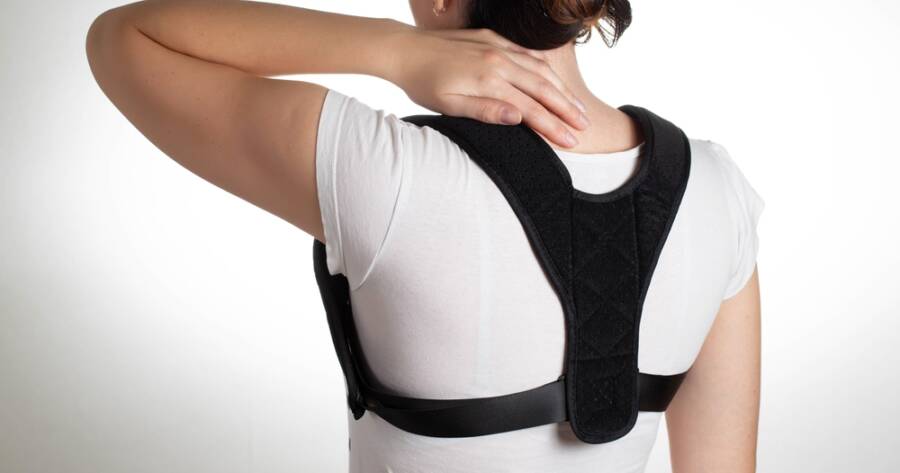If your back, neck, or shoulders start to ache after a few hours at your desk, poor posture is likely playing a role. Hunching over laptops, slouching in chairs, and craning our necks toward screens has become the modern default—and over time, it can lead to discomfort, muscle imbalance, and even long-term spinal issues.
Enter posture correctors and wearable alignment tools. These devices promise to train your body into better posture habits, ease back tension, and help you build muscle memory for long-term alignment. But not all posture aids are created equal. Take a look at a a range of options—straps, braces, and smart wearables—based on comfort, effectiveness, and usability during a real-life workday.
Best for Habit Training: Upright Go 2
Type: Smart wearable
Worn on: Upper back (adheres with reusable adhesive or worn on a necklace)
Use time: 10–30 minutes daily training + real-time reminders
The Upright Go 2 is a discreet, tech-powered posture trainer that vibrates gently whenever you start to slouch. It’s designed more to train your posture than to force it, helping you build awareness and strength over time. It pairs with an app that tracks your progress and allows you to adjust sensitivity and reminders.
Unlike rigid braces, the Upright Go 2 encourages active engagement of your core and back muscles. After a few days of regular use, most users start correcting posture automatically without needing a reminder. The adhesive holds up well and is reusable, but the optional necklace is a great alternative for daily use.
Pros: Smart, subtle, and highly effective for building long-term posture awareness
Cons: Requires daily charging and app syncing, works best with regular commitment
Best Traditional Brace: Mueller Adjustable Posture Corrector
Type: Physical posture brace
Worn on: Shoulders and upper back
Use time: 20–60 minutes per day
The Mueller brace is a classic solution for those who need a physical reminder to sit up straight. It pulls the shoulders gently back and provides light support to the upper back. It’s not meant to be worn all day—just for short periods to help reinforce good habits.
This model is more supportive than smart wearables but less invasive than heavy-duty orthopedic braces. It’s breathable and adjustable but can feel bulky under clothing. It’s best used while sitting at your desk or standing in one place—not ideal for lots of movement.
Pros: Affordable, easy to adjust, provides immediate alignment feedback
Cons: Can feel restrictive, not suitable for all-day wear
Best for Comfort and Discretion: BackEmbrace Posture Support
Type: Elastic posture band
Worn on: Upper back and shoulders
Use time: Up to a few hours per day
BackEmbrace takes a different approach by combining comfort with posture support. This soft, stretchable band is designed to gently pull the shoulders into alignment without pinching or squeezing. It’s slim enough to wear under most clothes, making it ideal for all-day use at the office.
Unlike rigid braces, BackEmbrace allows a full range of motion, which means it won’t interfere with tasks like typing or walking. It’s most helpful for subtle corrections and posture awareness rather than full structural support. Those with severe back problems might need something more robust, but for general desk-worker slouching, this wearable feels like a comfortable upgrade.
Pros: Lightweight, stylish, machine washable, easy to wear for longer periods
Cons: May not be supportive enough for more advanced posture issues
Best for Active Sitting: Gaiam Balance Ball Chair
Type: Ergonomic chair
Used for: Active sitting at a desk
Use time: 30 minutes to a few hours at a time
While not a wearable, the Gaiam Balance Ball Chair is worth mentioning for those looking to improve posture while working from a desk. This setup encourages better alignment by engaging your core and promoting spinal awareness throughout the day. You’ll naturally sit taller and shift less frequently into slouchy positions.
The chair isn’t meant for full-day use—it’s best to alternate between this and a supportive ergonomic chair. But for 30- to 60-minute sessions, it’s an effective and surprisingly fun way to train better posture and build core endurance.
Pros: Encourages active posture, strengthens core muscles, affordable alternative to standing desks
Cons: Takes time to get used to, may not work for people with back pain or balance issues
What Actually Improves Posture Long-Term?
The key to improved posture isn’t forcing your spine into a fixed position—it’s building the awareness and strength to support your body naturally. Devices like the Upright Go 2 and BackEmbrace do this well by nudging your body without doing all the work for you. Traditional braces like the Mueller model are useful for short-term corrections but aren’t recommended for long-term wear, as they can reduce your muscles’ ability to engage on their own.
No matter which device you choose, the most important part of improving your posture is pairing it with good daily habits. Take movement breaks, stretch your chest and shoulders, and adjust your desk setup for better ergonomics. Used correctly, these tools can support those efforts—and help you ditch the slouch for good.

